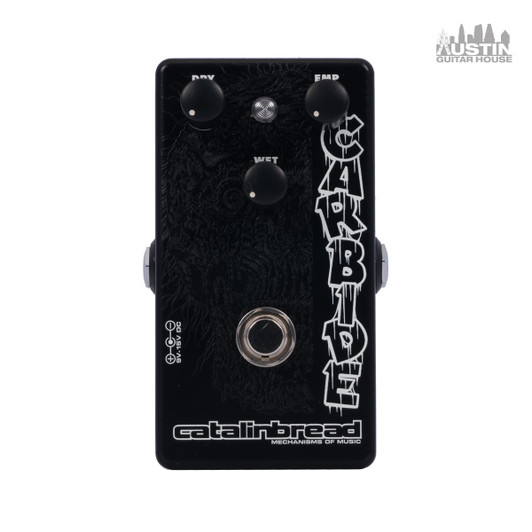
AUSTIN GUITAR HOUSE IS PROUD TO BE AN AUTHORIZED DEALER OF

From the years of 1966 to 1968, Mosrite produced two distinct fuzz circuits---one outfitted with silicon transistors, the other with germanium parts. Of the two, the germanium version is by far the most rare, with original designer and Mosrite employee Ed Sanner estimating that around 250 ever made it out the door. In that final year of production, Mosrite shifted exclusively to silicon parts, making germanium components a thing of the past. However, by 1968 the public was hungry for fuzz, having heard it on a handful of recordings, most notably "In-A-Gadda-Da-Vida" by Iron Butterfly and "Incense and Peppermints" by Strawberry Alarm Clock. These two buzzy, sinewy fuzz tones were part of a wave of psychedelic rock gaining traction in the mainstream, and both were recorded prior to the introduction of the silicon Fuzzrite. Other purported users of this early Fuzzrite circuit include Ron Asheton of the Stooges, Norman Greenbaum on "Spirit in the Sky", Henry Vestine of Canned Heat, and many others.
At Catalinbread, they happen to have a germanium version at their disposal, and they've used it as a benchmark to create an extremely faithful version with a modern twist. Just like the original, the Catalinbread Fuzzrite Germanium includes two NOS PNP germanium semiconductors with a polarity inverter IC so it plays nice with all forms of power. Unlike the original, it also has a toggle switch to shift into modern mode, significantly beefing up the low-end content to suit more contemporary rigs.
VOLUME - controls the output volume of the circuit. Higher settings will begin to overdrive your amplifier, which can add additional body and smoothness to the fuzzed-out sounds. Crank it up!
DEPTH - the heart of the pedal. This knob is essentially a blend control that mixes in a second transistor gain stage with the first. At the minimum setting, you're hearing the first transistor on its own - cleanish and fat. As you begin to blend in the second transistor, at various points along the way you will notice more voltage-starved, gated sounds; pseudo ring mod-style upper octave harmonics; and at max settings a thinner, more aggressive saturated sound with a ripping top-end attack and huge bloom to the notes.
M/V (MODERN/VINTAGE) TOGGLE: The Fuzzrite is composed of two simple, separate gain stages. What the Depth knob actually controls is a mix of sorts. When the knob is all the way down, you get just the first stage. When the knob is all the way up, you get the first running into the second. You never hear just the second one by itself, Depth is just a mix control between "1" and "1+2". With all that said, "1" and "2" are different circuits BUT they both have a very small output capacitor. The input and output caps (but mostly the output caps) have a dramatic effect on how much low end is heard in the final product. No matter where the Depth control is set, the signal travels directly through a small capacitor which cuts the low end. "Vintage" is the stock value, 2nF. "Modern" switches both output capacitors from 2nF to 10nF, increasing the amount of low end passing through (it should be noted that this capacitor/low end quantization is not "linearly upscalable" in that 10nF is not "five times the bass" of the original or whatever, it's just "more").
SIGNAL CHAIN PLACEMENT:
Being an old school fuzz that is responsive to your pick attack and the guitar’s controls, it's best to place it first in your chain of effects to get the best dynamic response. If that isn't practical for you, just make sure there are no buffers in front of the pedal as they can severely limit the dynamic potential when you use your guitar’s controls. If you are planning on stacking the Fuzzrite with other dirt pedals, it pays to experiment with the running order of things as you can have dramatically different outcomes based on that order.
The Fuzzrite can accept a 9v battery, or any good quality 9vDC adapter for use with audio circuits that is filtered and regulated with a center-negative tipped plug. The Fuzzrite has a very low mA draw, so batteries will last quite a long time. Be sure to unplug the input cable to preserve battery life when not in use.